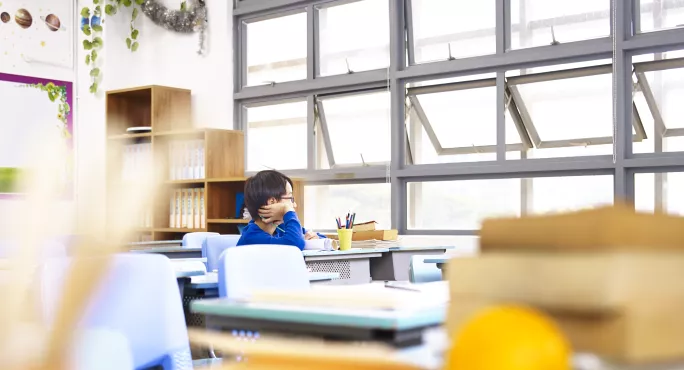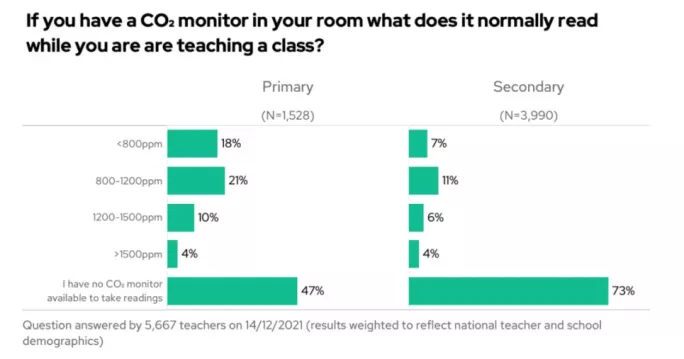Zahawi accused of ‘failing’ schools over classroom air safety

The education secretary has been accused of “failing schools” after he said the government would allocate just 8,000 air purifiers to schools to help reduce the spread of Covid in classrooms.
Nadhim Zahawi told MPs on Wednesday that the Department for Education’s allocation of 8,000 air purifiers for schools was backed up by Teacher Tapp data, which showed that just 4 per cent of teachers said they had readings on carbon-dioxide monitors above the safe threshold set by the DfE.
Mr Zahawi added that purchasing more units for schools would be a “waste of taxpayers’ money”.
However, Teacher Tapp has said that almost three-quarters (73 per cent) of secondary teachers and nearly half (47 per cent) of primary teachers surveyed could not submit data because they had not received CO2 monitors to test their classroom ventilation.
- Unions: Omicron plan for schools ‘totally inadequate’
- Omicron: Primary school pupils may need masks, say experts
- Covid: How schools can apply for air purifier units from the DfE
Teacher Tapp co-founder Laura McInerney said she would expect the percentage of classrooms needing air purifiers (which would require a consistent CO2 reading of over 1500 ppm) to double to 16,000 - or 8 per cent - if all classrooms were measured.
She added that the fact that the readings are unknown in huge numbers of classrooms without monitors is “a massive problem”.

Last autumn, the DfE announced plans for 350,000 CO2 monitors to be sent to “all state schools” in a bid to help them combat the spread of Covid.
However, in a poll from school staff union the NASUWT published this week, over half (56 per cent) of almost 2,000 teachers surveyed said they did not have access to a CO2 monitor in their classroom, and over a third (34 per cent) of those that had monitors reported CO2 levels often or sometimes exceeding 1500ppm in their classrooms.
Covid: DfE ‘not equipping schools to improve ventilation’
NASUWT general secretary Dr Patrick Roach said the poll showed that the “government’s promise barely scratches the surface in terms of what is needed to ensure that every classroom is adequately ventilated”.
“Ministers have consistently emphasised the importance of ensuring good ventilation in heavily populated settings as a key mitigation in reducing the spread of Covid-19, yet they have consistently failed throughout this pandemic to ensure schools and colleges can be kept as safe as possible by equipping schools with the tools to improve classroom ventilation,” he added.
Labour shadow schools minister Stephen Morgan said the government’s allocation of air purifiers was “based on a concerningly incomplete picture”, adding that it was “yet more evidence” of the education secretary’s “incompetent, complacent and inadequate response to classroom ventilation”.
“The apparent discrepancies in the education secretary’s figures are yet more evidence of his incompetent, complacent and inadequate response to classroom ventilation,” he said.
“The apparent discrepancies in the education secretary’s figures are yet more evidence of his incompetent, complacent and inadequate response to classroom ventilation.”
Meanwhile, headteacher unions said that it is likely the DfE has “underestimated” the number of air purifiers needed in schools and that demand could “outstrip supply”.
Paul Whiteman, general secretary of school leaders’ union the NAHT, said the government still does not have adequate data on the number of classrooms where air quality fails to meet expected levels.
“It is impossible to say with any certainty whether the provision of 7,000 air filters [the 8,000 included a previously announced 1,000 for special schools and alternative provision] will be sufficient to meet need, but given that there are upwards of a quarter-of-a-million classrooms in England, it is reasonable to think that demand could easily outstrip supply,” he said.
“Where schools need air filtration units to improve areas of poor ventilation, they should be provided with them, without delay. We will encourage government to monitor demand and to make more available as required, to ensure all schools that need one, get one. Adequate ventilation in classrooms should not be limited to first come, first served.”
Geoff Barton, general secretary of the Association of School and College Leaders, agreed that it seemed “very likely that the government has underestimated the number of air cleaning units that will be needed by schools and colleges”.
“These units are not a substitute for ventilation but are intended for classrooms that suffer from poor ventilation because of their age and design, and where it is not possible to immediately solve this problem,” he said.
Mr Barton added that what he would like to see is a “needs-based approach”, with the government providing as many air cleaning units as required rather than limiting the provision to a specific number.
“This does not seem unreasonable in the context of the ongoing disruption being experienced as a result of the pandemic and the enormous challenge of keeping children in the classroom and staff in the workplace amidst very high rates of transmission.”
However, when Mr Zahawi was pressed on whether he would order more air purifiers for schools by shadow education secretary Bridget Phillipson in the House of Commons on Wednesday, he claimed that buying extra units would be a “waste of taxpayers’ money”.
Schools applying for air purifiers
From 2 January, schools could apply to receive air purifiers from the DfE if they met certain criteria, which included that the purifiers could not be applied for use in staffrooms, halls, corridors and dining rooms.
Last year, Tes revealed than four in five teachers were not reassured by CO2 monitors, while almost a third said they did not teach in well-ventilated classrooms.
The monitors record the levels of carbon dioxide in the room, indicating how well ventilated the space is (or isn’t). For a classroom, levels over 1500 ppm are seen as inadequate and at this point the Health and Safety Executive states “you should take action”.
However, it also states that CO2 levels below 800ppm are recommended for areas with continuous talking or singing, indicating that a loud classroom might reach poor ventilation when levels reach above 800ppm.
The DfE has been contacted for comment.
You need a Tes subscription to read this article
Subscribe now to read this article and get other subscriber-only content:
- Unlimited access to all Tes magazine content
- Exclusive subscriber-only stories
- Award-winning email newsletters
Already a subscriber? Log in
You need a subscription to read this article
Subscribe now to read this article and get other subscriber-only content, including:
- Unlimited access to all Tes magazine content
- Exclusive subscriber-only stories
- Award-winning email newsletters
topics in this article



